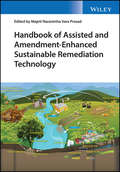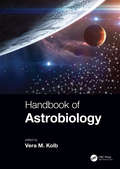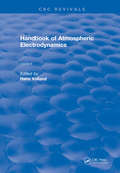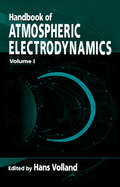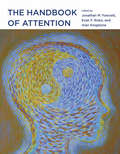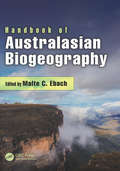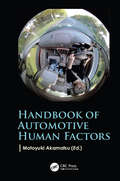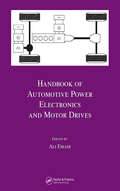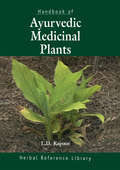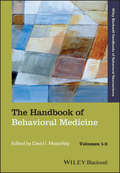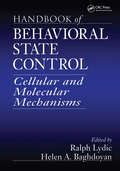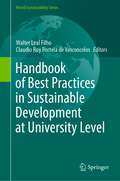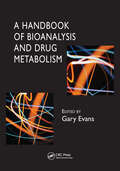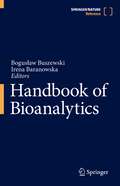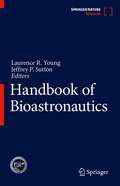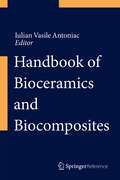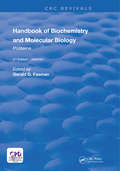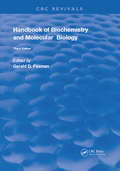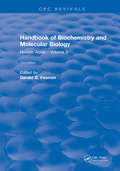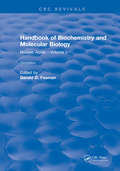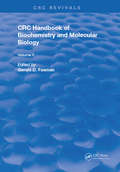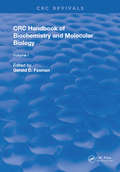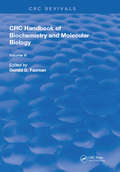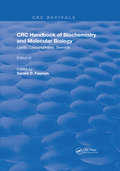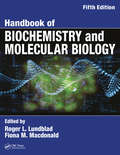- Table View
- List View
Handbook of Assisted and Amendment-Enhanced Sustainable Remediation Technology
by M. N V PrasadLearn more about phytoremediation technology with this state-of-the-art resource from an internationally recognized editor and leader in his field The Handbook of Assisted and Amendment-Enhanced Sustainable Remediation Technology discusses sustainable approaches to the removal of contaminants from the environment or the reduction of their toxicity. The distinguished editor has included resources from an internationally recognized group of academics who discuss strategies to increase the effectiveness of phytoremediation. Special attention is paid to the use of organic amendments to facilitate soil cleanup and the growth of phytoremediation plants. The book includes discussions of new remediation technologies, global trends in the environmental remediation industry, and the future challenges and opportunities likely to arise in the short and long term. The Handbook of Assisted and Amendment-Enhanced Sustainable Remediation Technology provides a compelling case for the cost-effectiveness, aesthetics, and minimal environmental disturbance of phytoremediation. Topics covered include: A discussion of activated carbon from lignin, particularly its use as a sorbent for in situ remediation of contaminated sediments An exploration of fresh and mature organic amendments for phytoremediation of technosols contaminated with high concentrations of trace elements An examination of the revitalization of metal-contaminated, EDTA-washed soil by addition of unpolluted soil, compost, and biochar A treatment of wheat straw biochar amendments on the removal of polycyclic aromatic hydrocarbons (PAHs) in contaminated soil Perfect for environmental engineers, environmental scientists, geologists, chemical engineers, and landscape engineers, Handbook of Assisted and Amendment-Enhanced Sustainable Remediation Technology is also an indispensable reference for scientists working in the green chemistry and technology industries, biochemical engineers, environmental regulators, and policy makers.
Handbook of Astrobiology (Series in Astrobiology)
by Vera M. KolbRead an exclusive interview with Professor Vera Kolb here. Astrobiology is the study of the origin, evolution, distribution, and future of life on Earth. This exciting and significant field of research also investigates the potential existence and search for extra-terrestrial life in the Solar System and beyond. This is the first handbook in this burgeoning and interdisciplinary field. Edited by Vera Kolb, a highly respected astrobiologist, this comprehensive resource captures the history and current state of the field. Rich in information and easy to use, it assumes basic knowledge and provides answers to questions from practitioners and specialists in the field, as well as providing key references for further study. Features: Fills an important gap in the market, providing a comprehensive overview of the field Edited by an authority in the subject, with chapters written by experts in the many diverse areas that comprise astrobiology Contains in-depth and broad coverage of an exciting field that will only grow in importance in the decades ahead
Handbook of Atmospheric Electrodynamics: Volume II (CRC Press Revivals)
by Hans VollandThe participation of such diverse scientific and technical disciplines as meteorology, astronomy, atmospheric electricity, ionospheric and magnetospheric physics, electromagnetic wave propagation, and radio techniques in the research of atmospherics means that results are published in scientific papers widely spread throughout the literature. This Handbook collects the latest knowledge on atmospherics and presents it in two volumes. Each chapter is written by an expert in his or her field. Topics include the physics of thunderclouds, thunder, global atmospheric electric currents, biological aspects of sferics, and various space techniques for detecting lightning within our own atmosphere as well as in the atmospheres of other planets. Up-to-date applications and methodology are detailed. Volumes I and II offer a comprehensive discussion that together will serve as an important resource for practitioners, professionals, and students alike.
Handbook of Atmospheric Electrodynamics, Volume I: Volume Ii (Crc Press Revivals Ser.)
by Hans VollandThe participation of such diverse scientific and technical disciplines as meteorology, astronomy, atmospheric electricity, ionospheric and magnetospheric physics, electromagnetic wave propagation, and radio techniques in the research of atmospherics means that results are published in scientific papers widely spread throughout the literature. This Handbook collects the latest knowledge on atmospherics and presents it in two volumes. Each chapter is written by an expert in his or her field. Topics include the physics of thunderclouds, thunder, global atmospheric electric currents, biological aspects of sferics, and various space techniques for detecting lightning within our own atmosphere as well as in the atmospheres of other planets. Up-to-date applications and methodology are detailed. Volumes I and II offer a comprehensive discussion that together will serve as an important resource for practitioners, professionals, and students alike.
The Handbook of Attention (The\mit Press Ser.)
by Jonathan M. FawcettAn authoritative overview of current research on human attention, emphasizing the relation between cognitive phenomena observed in the laboratory and in the real world. Laboratory research on human attention has often been conducted under conditions that bear little resemblance to the complexity of our everyday lives. Although this research has yielded interesting discoveries, few scholars have truly connected these findings to natural experiences. This book bridges the gap between “laboratory and life” by bringing together cutting-edge research using traditional methodologies with research that focuses on attention in everyday contexts. It offers definitive reviews by both established and rising research stars on foundational topics such as visual attention and cognitive control, underrepresented domains such as auditory and temporal attention, and emerging areas of investigation such as mind wandering and embodied attention. The contributors discuss a range of approaches and methodologies, including psychophysics, mental chronometry, stationary and mobile eye-tracking, and electrophysiological and functional brain imaging. Chapters on everyday attention consider such diverse activities as driving, shopping, reading, multitasking, and playing videogames. All chapters present their topics in the same overall format: historical context, current research, the possible integration of laboratory and real-world approaches, future directions, and key and outstanding issues. ContributorsRichard A. Abrams, Lewis Baker, Daphne Bavelier, Virginia Best, Adam B. Blake, Paul W. Burgess, Alan D. Castel, Karen Collins, Mike J. Dixon, Sidney K. D'Mello, Julia Föcker, Charles L. Folk, Tom Foulsham, Jonathan A. Fugelsang, Bradley S. Gibson, Matthias S. Gobel, Davood G. Gozli, Arthur C. Graesser, Peter A. Hancock, Kevin A. Harrigan, Simone G. Heideman, Cristy Ho, Roxane J. Itier, Gustav Kuhn, Michael F. Land, Mallorie Leinenger, Daniel Levin, Steven J. Luck, Gerald Matthews, Daniel Memmert, Stephen Monsell, Meeneley Nazarian, Anna C. Nobre, Andrew M. Olney, Kerri Pickel, Jay Pratt, Keith Rayner, Daniel C. Richardson, Evan F. Risko, Barbara Shinn-Cunningham, Vivian Siu, Jonathan Smallwood, Charles Spence, David Strayer, Pedro Sztybel, Benjamin W. Tatler, Eric T. Taylor, Jeff Templeton, Robert Teszka, Michel Wedel, Blaire J. Weidler, Lisa Wojtowicz, Jeremy M. Wolfe, Geoffrey F. Woodman
Handbook of Australasian Biogeography (CRC Biogeography Series)
by Malte C. EbachThe Handbook of Australasian Biogeography is the most comprehensive overview of the biogeography of Australasian plants, fungi and animal taxa in a single volume. This volume is unique in its coverage of marine, freshwater, terrestrial, and subterranean taxa. It is an essential publication for anyone studying or researching Australasian biogeography. The book contains biogeographic reviews of all major plant, animal and fungal groups in Australasia by experts in the field, including a strong emphasis on invertebrates, algae, fungi and subterranean taxa. It discusses how Australasia is different from the rest of the world and what other areas share its history and biota.
Handbook of Automotive Human Factors
by Motoyuki AkamatsuThanks to advances in computer technology in the last twenty years, navigation system, cabin environment control, ACC, advanced driver assistance system (ADAS) and automated driving have become a part of the automobile experience. Improvement in technology enables us to design these with greater flexibility and provide greater value to the driver (human centered design). To achieve this, research is required by laboratories, automobile and auto parts manufacturers. Although there has been a lot of effort in human factors research and development, starting from basic research to product development, the knowledge and experience has not been integrated optimally. <p><P>The aim of this book is to collect and review the information for researchers, designers and developers to learn and apply them for further research and development of human centered design of future automotive technologies. Automotive human factors include psychological, physiological, mathematical, engineering and even sociological aspects. This book offers valuable insights to applying the right approach in the right place.
Handbook of Automotive Power Electronics and Motor Drives (Electrical and Computer Engineering #Vol. 125)
by Ali EmadiInitially, the only electric loads encountered in an automobile were for lighting and the starter motor. Today, demands on performance, safety, emissions, comfort, convenience, entertainment, and communications have seen the working-in of seemingly innumerable advanced electronic devices. Consequently, vehicle electric systems require larger capacities and more complex configurations to deal with these demands. Covering applications in conventional, hybrid-electric, and electric vehicles, the Handbook of Automotive Power Electronics and Motor Drives provides a comprehensive reference for automotive electrical systems.This authoritative handbook features contributions from an outstanding international panel of experts from industry and academia, highlighting existing and emerging technologies. Divided into five parts, the Handbook of Automotive Power Electronics and Motor Drives offers an overview of automotive power systems, discusses semiconductor devices, sensors, and other components, explains different power electronic converters, examines electric machines and associated drives, and details various advanced electrical loads as well as battery technology for automobile applications.As we seek to answer the call for safer, more efficient, and lower-emission vehicles from regulators and consumer insistence on better performance, comfort, and entertainment, the technologies outlined in this book are vital for engineering advanced vehicles that will satisfy these criteria.
Handbook of Ayurvedic Medicinal Plants: Herbal Reference Library
by L.D. KapoorThis handbook is filled with over 50 illustrations and descriptions of approximately 250 plants which are used for herbal medicine. It includes information on medicinal plants ranging from Abies spectabilis to Zizyphus vulgaris. The purpose of this handbook is to make available a reference for easy, accurate identification of these herbs. Derived from India, ""Ayurveda"" is the foundation stone of their ancient medical science. Approximately 80 percent of the population of India and other countries in the East continue to utilize this system of medicinal treatment. It is believed that the key to successful medication is the use of the correct herb. This is an indispensable resource for all physicians, pharmacists, drug collectors, and those interested in the healing arts.
The Handbook of Behavioral Medicine (Blackwell Handbooks of Behavioral Neuroscience)
by David I. MostofskyHandbook of Behavioral Medicine presents a comprehensive overview of the current use of behavioral science techniques in the prevention, diagnosis, and treatment of various health related disorders. Features contributions from a variety of internationally recognized experts in behavioral medicine and related fields Includes authors from education, social work, and physical therapy Addresses foundational issues in behavioral medicine in Volume 1, including concepts, theories, treatments, doctor/patient relationships, common medical problems, behavioral technologies, assessment, and methodologies Focuses on medical interface in Volume 2, including issues relating to health disorders and specialties; social work, medical sociology, and psychosocial aspects; and topics relating to education and health 2 Volumes
Handbook of Behavioral State Control: Cellular and Molecular Mechanisms
by Ralph Lydic Helen A. BaghdoyanHandbook of Behavioral State Control: Cellular and Molecular Mechanisms provides the first synthesis of information on the neurobiology of behavioral states, ranging from normal stress and sleep deprivation to debilitating neuropsychiatric disorders. This book presents a working reference on the cellular and molecular mechanisms generating arousal
Handbook of Best Practices in Sustainable Development at University Level (World Sustainability Series)
by Walter Leal Filho Claudio Ruy Portela de VasconcelosThis book gives a special emphasis to state-of-the-art descriptions of approaches, methods, initiatives, and projects from universities, stakeholders, organizations, and civil society across the world, regarding cross-cutting issues in sustainable development.There is a perceived need for mobilizing the various stakeholders when attempting to promote sustainability in higher education and to promote best practices, which may inspire further initiatives. But despite this need, there are a few publications handling this matter in a coherent way. In order to meet the pressing need for publications which may document and disseminate examples of best practice on sustainable development at university level, the “Handbook of Best Practices in Sustainable Development at University Level” is being published.This book is produced by the European School of Sustainability Science and Research (ESSSR), through the Inter-University Sustainable Development Research Programme (IUSDRP) and contains inputs from authors across all geographical regions.The book also discusses examples of initiatives coordinated by universities but involving civil society, the private sector, and public sector (including local, national, and intergovernmental bodies). In particular, it describes practical experiences, partnerships, networks, and training schemes for building capacity aimed at fostering the cause of sustainable development at institutions of higher education.Thanks to its design and the contributions by experts from various areas, it provides a welcome contribution to the literature on sustainable development, and it may inspire further works in this field.
A Handbook of Bioanalysis and Drug Metabolism
by Gary EvansRecent years have seen a greater industrial emphasis in undergraduate and postgraduate courses in the pharmaceutical and chemical sciences. However, textbooks have been slow to adapt, leaving the field without a text/reference that is both instructional and practical in the industrial setting – until now. A Handbook of Bioanalysis and Drug Metabolismis a stimulating new text that examines the techniques, methodology, and theory of bioanalysis, pharmacokinetics, and metabolism from the perspective of scientists with extensive professional experience in drug discovery and development. These three areas of research help drug developers to optimize the active component within potential drugs thereby increasing their effectiveness, and to provide safety and efficacy information required by regulators when granting a drug license. Professionals with extensive experience in drug discovery and development as well as specialized knowledge of the individual topics contributed to each chapter to create a current and well-credentialed text. It covers topics such as high performance liquid chromatography, protein binding, pharmacokinetics and drug–drug interactions. The unique industrial perspective helps to reinforce theory and develop valuable analytical and interpreting skills. This text is an invaluable guide to students in courses such as pharmaceutical science, pharmacology, chemistry, physiology and toxicology, as well as professionals in the biotechnology industry.
Handbook of Bioanalytics
by Bogusław Buszewski Irena BaranowskaThis book presents an authoritative review of analytical methods used for diagnostics, medical therapy and for forensic purposes. Divided into 4 parts, the book discusses new challenges in bioanalytics, covers bioanalysis as a source of clinical, pharmaceutical and forensic information, explores natural resources as a source of biologically active compounds, and offers new analytical strategies and equipment solutions. Written by interdisciplinary expert academics, this work will appeal to a wide readership of students, researchers and professionals interested in the fields of medicine, chemistry, pharmaceutical, life and health sciences, engineering and environmental protection. Clinicians and employees of forensic laboratories will also find this work instructive and informative.
Handbook of Bioastronautics
by Laurence R. Young Jeffrey P. SuttonThis comprehensive handbook serves the needs of biomedical researchers, space mission planners and engineers, aerospace medicine physicians, graduate students, and professors interested in obtaining an up-to-date and readable introduction to bioastronautics, the science of humans in space. Following the excitement and progress of the birth of the space age in the fifties and sixties, with the successes in human space flight – culminating with the Moon landings – the field of bioastronautics retreated into the more workmanlike arena of successively longer stays in low Earth orbit. At this time, major new initiatives are ahead both in human and robotic space exploration. The International Space Station, along with the developing Chinese space station and lunar program, will permit the development and testing of the means of astronaut protection for long duration missions – eventually to Mars and its moons, as well as visits to asteroids, other NEOs, and the Lagrange points. New life support systems and innovative approaches to radiation protection beyond Earth’s magnetic field will all be developed and tested. Meanwhile, the search for extraterrestrial life, past or even present, is accelerating – with the spectacular finds of Martian water and the discovery of potentially habitable extra-solar planets. A new generation of scientists is ready to attack a new set of problems, and is in need of an efficient, accurate and searchable means of discovering the essentials of the field. This reference work also covers the challenges, past achievements, and potential solutions inherent to the safe exploration of distant space and the search for life off our planet. The entries summarize the tertiary literature and include sufficient data and illustrations to introduce each topic, while avoiding the length and detail of scientific review articles.
Handbook of Bioceramics and Biocomposites
by Iulian Vasile AntoniacThis handbook describes several current trends in the development of bioceramics and biocomposites for clinical use in the repair, remodelling, and regeneration of bone tissue. Comprehensive coverage of these materials allows fundamental aspects of the science and engineering to be seen in close relation to the clinical performance of dental and orthopaedic implants. Bioceramics and biocomposites appear to be the most dynamic area of materials development for both tissue engineering and implantable medical devices. Almost all medical specialties will continue to benefit from these developments, but especially dentistry and orthopaedics. In this Handbook, leading researchers describe the use of bionanomaterials to create new functionalities when interfaced with biological molecules or structures. Also described are technologies for bioceramics and biocomposites processing in order to fabricate medical devices for clinical use. Another important section of the book is dedicated to tissue regeneration with development of new matrices. A targeted or personalized treatment device reduces drug consumption and treatment expenses, resulting in benefits to the patient and cost reductions for public health systems. This authoritative reference on the state-of-the-art in the development and use of bioceramics and biocomposites can also serve as the basis of instructional course lectures for audiences ranging from advanced undergraduate students to post-graduates in materials science and engineering and biomedical engineering.
Handbook of Biochemistry: Section A Proteins, Volume I (Routledge Revivals Ser.)
by Gerald D FasmanThis first volume contains data on amino acids which consists of the coefficients of solubility in water, heat capacities, entropies of formation, and heats of combustion. Specific gravity liquids, sucrose solution, CsCI solution isokinetic glycerol and sucrose gradients for density gradient centrifugation and the temperature dependence for select compounds are included.
Handbook of Biochemistry: Section C Lipids Carbohydrates & Steroids, Volume l (Routledge Revivals Ser.)
by Gerald D FasmanThis first volume contains data on amino acids which consists of the coefficients of solubility in water, heat capacities, entropies of formation, and heats of combustion. Specific gravity liquids, sucrose solution, CsCI solution isokinetic glycerol and sucrose gradients for density gradient centrifugation and the temperature dependence for select compounds are included.
Handbook of Biochemistry: Section B Nucleic Acids, Volume II (Routledge Revivals Ser.)
by Gerald D FasmanThe section of this handbook has been dividing into two volumes, the first volume contains information relating to purines, pyrimidine and nucleoside, oligonucleotide, polynucleotides, and their derivatives. Both ribo and deoxyribo compounds are listed also. The second volume will contain the remaining material similar to Volume 1 and material more relative to genetic and biological aspects such as enzymes involved in nucleic acid function, protein synthesis, linkage maps.
Handbook of Biochemistry: Section B Nucleic Acids, Volume I (Routledge Revivals Ser.)
by Gerald D FasmanThis volume contains information on the nucleotide composition of bacterial DNA. Eukaryotic protists, etc.; Nearest neighbour frequencies in DNA; repeated and unique sequences in eukaryotes; nucleic acid sequences in bacteriophage, chloroplasts, mitochondria, kinetoplasts, satellites and TRNA. Information on the physical properties of RNA, atomic coordinates of DNA-DNA. Also included in this volume is information on enzymes involved in nucleic acid function.
Handbook of Biochemistry: Section A Proteins, Volume II (Routledge Revivals Ser.)
by Gerald D FasmanThe fields of biochemistry and molecular biology are two areas in which the information explosion is manifest.
Handbook of Biochemistry: Section D Physical Chemical Data, Volume I (Routledge Revivals Ser.)
by Gerald D FasmanThis first volume contains data on amino acids which consists of the coefficients of solubility in water, heat capacities, entropies of formation, and heats of combustion. Specific gravity liquids, sucrose solution, CsCI solution isokinetic glycerol and sucrose gradients for density gradient centrifugation and the temperature dependence for select compounds are included.
Handbook of Biochemistry: Section A Proteins, Volume III (Routledge Revivals Ser.)
by Gerald D FasmanThis edition focuses solely on proteins, amino acids venom toxins and peptides, haemoglobin. It also gives us very detailed information regarding cell types, anti-bodies, infrared testing on protein cells and membrane studies.
Handbook of Biochemistry and Molecular Biology: Lipids Carbohydrates, Steroids (Routledge Revivals)
by Gerald D. FasmanPublished in 1975: This volume contains the completed section of the Handbook of Biochemistry and Molecular Biology with data pertaining to Lipids, Carbohydrates, and Steroids.
Handbook of Biochemistry and Molecular Biology
by Roger L. Lundblad Fiona MacdonaldEdited by renowned protein scientist and bestselling author Roger L. Lundblad, with the assistance of Fiona M. Macdonald of CRC Press, this fifth edition of the Handbook of Biochemistry and Molecular Biology gathers a wealth of information not easily obtained, including information not found on the web. Presented in an organized, concise, and simple-to-use format, this popular reference allows quick access to the most frequently used data. Covering a wide range of topics, from classical biochemistry to proteomics and genomics, it also details the properties of commonly used biochemicals, laboratory solvents, and reagents. An entirely new section on Chemical Biology and Drug Design gathers data on amino acid antagonists, click chemistry, plus glossaries for computational drug design and medicinal chemistry. Each table is exhaustively referenced, giving the user a quick entry point into the primary literature. New tables for this edition: Chromatographic methods and solvents Protein spectroscopy Partial volumes of amino acids Matrix Metalloproteinases Gene Editing Click Chemistry
